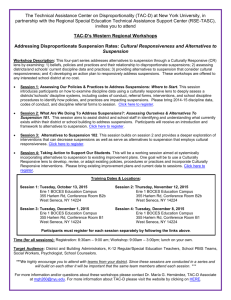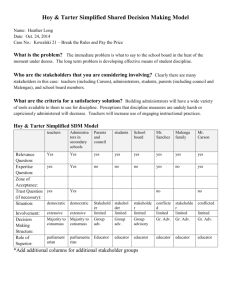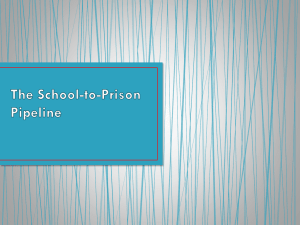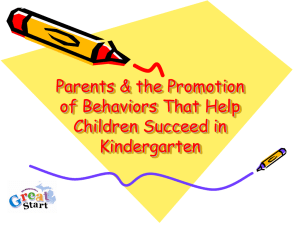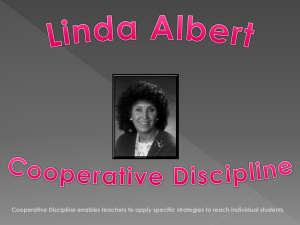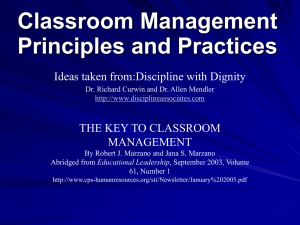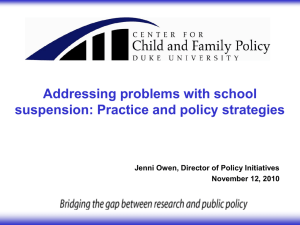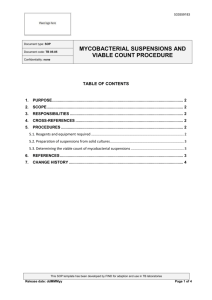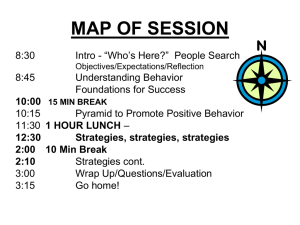Closing the School Discipline Gap
advertisement
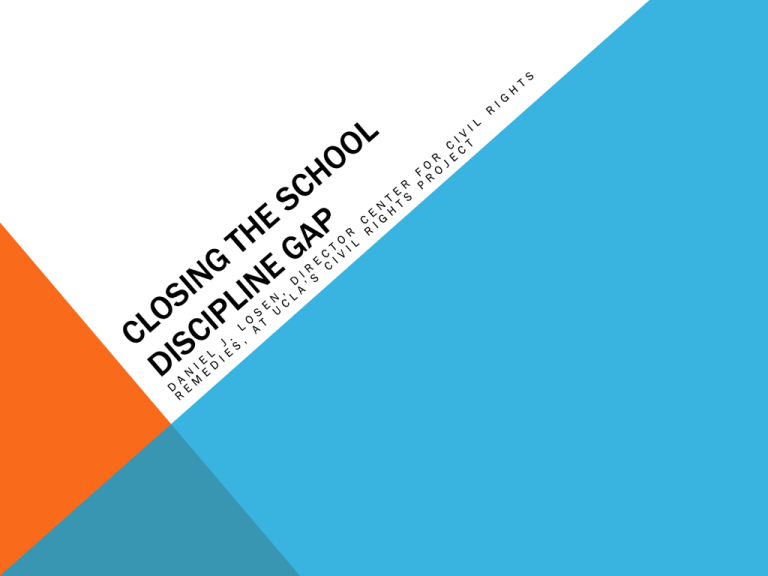
THE PLEDGE OF ILLUSIONS Suspensions are meted out fairly. Most teachers are not biased. You have to kick out the “bad” kids so the “good” kids can learn. Suspensions are only used as measures of last resort and necessary to ensure safety. Suspending students out of school has no associated “costs.” Schools have no alternatives. It’s only discrimination if similarly situated students were treated differently. We know the full extent of disciplinary exclusion and its impact. There is an easy and quick solution. NATIONAL DATA (2009-10) SHOW SUSPENSION RATES AT THE SECONDARY LEVEL ARE TYPICALLY 4 TO 10 TIMES HIGHER THAN ELEMENTARY LEVEL 30 24.3 25 All 19.3 20 Amer. Indian Asian African Amer. 15 Latino 12 11.3 10 11.3 Els 8.4 7.1 6.6 4.1 5 2.4 1.8 1.7 0.2 1.1 1.2 2.3 0 Elementary White Secondary With Disabilitiy SECONDARY SUSPENSION RATES: THEN AND NOW 30 25 24.3 20 15 11.8 12 10 8.4 5 6.1 6 5.6 2.4 7.1 2.3 0 1972-73 2009-10 Black White Latino American Ind. Asian American NATIONALLY, SUSPENSION RISE DRAMATICALLY WITH THE INTERSECTION OF RACE AND EL WITH DISABILITY, FURTHER DIVIDED BY GENDER National: Students With Disabilities Secondary Level Suspension Risk 40 36 35 30 25 Note Black Females’ High Rate 22 22 23 20 15 19 17 Male 12 10 10 6 7 5 0 ALL AA L W Els Female SYRACUSE PROFILE 2009-2010 RISK FOR SUSPENSION AT THE ELEMENTARY AND SECONDARY LEVELS BY SELECTED SUBGROUPS THE FRAMEWORK OF ANTI-DISCRIMINATION LAW AND THE NEW GUIDANCE A. Different Treatment: Similarly situated students are disciplined differently. Are Black students, and students with disabilities misbehaving more? B. Disparate Impact: Is a protected subgroup adversely impacted by a policy or practice? Is there an educational necessity for the policy or practice? Or Are there less discriminatory alternatives? C. Denial of FAPE is a form of discrimination against students with disabilities. CALIFORNIA: FREQUENT AND DISPARATE USE OF OUT-OF-SCHOOL SUSPENSION FOR MINOR OFFENSES UNDER DISRUPTION/WILLFUL DEFIANCE COMPARED WITH SERIOUS VIOLATIONS BY RACE AND DISABILITY STATUS Number of out-of-school suspensions per 100 students 16 14 White Students with Disabilities: Out-of-School Suspensions per 100 Students 12 Black Students with Disabilities: Out-of-School Suspensions per 100 Students 15.0 suspensions Gap 10.1 10 8 6 4 2 0 Gap 4.2 7.1 suspensions 4.9 suspensions 2.9 suspensions Serious offenses involving weapons, drugs, and violence with injury Willful defiance RACIAL DISPARITIES IN USE OF SUSPENSION FOR FIRST TIME OFFENDERS BY TYPE OF OFFENSE THE KNIFE An example of White privilege in America. RACIAL “IMPLICIT” BIAS Implicit bias and its implications: a. Perceptions of behavior. (Accidental possession?). b. Responses to behavior. (Trusting that no charges were needed). c. School examples…. “Bag man” for a gambling ring….Horseplay or gang activity? d. www.implicit.harvard.edu e. Difficult to address legally, but can be addressed in remedies. ATTITUDES OF PRINCIPALS Strongest predictor of suspension use and… Strongest predictor of racial disproportionality in discipline (Skiba 2014). Leadership matters. DATA DEFICIENCIES We don’t have annual collection of disaggregated discipline data. We don’t collect data on reasons for suspension or offenses as part of the CRDC Data reporting requirements are flaunted by most states (IDEA) and many districts (OCR). Irregularly collected and reported data are often not used and are less useful than they could be. School policing? Cops or counselors? But data are improving…. DISPARATE IMPACT Is it (frequent use of suspension or removal from school) educationally justifiable? Reasons: School climate? School outcomes (Balfanz, Schollenberger, Skiba) Safety (Finn)(Osher)(Steinberg) Deterrent? (American Psychological Association) Get parents attention? (CDC and Academy of American Pediatrics) Blame the parents (mine are in the audience). Common sense…(Dress codes and truancy) COMPLAINT AGAINST DISCIPLINE AND TRACKING Access to equal educational opportunity. Connections: Decisions educators make …sorting kids, resources, communication with parents… Challenge of addressing discipline disparities in a vacuum. Ivory Toldson and Robert Balfanz…need to address academic needs not just discipline. DISCIPLINE DISPARITIES (K-12) BY DISABILITY CATEGORY (2010-11) ALL U.S AVG ED OHI 10-13% 29% 14% SLD MR 12% 9% DISABILITY LAW Violating FAPE is enough evidence to assert discrimination on the basis of disability. Students with disabilities are entitled to extra procedural protections to ensure they aren’t being excluded on disciplinary grounds because of their disability… which is unlawful. Disparate impact of failing to adequately meet the needs of students with disabilities. Increasing pressure to address the impact of FAPE denial. REMEDIES = LESS DISCRIMINATORY ALTERNATIVES Teacher Training Restorative practices Social Emotional Learning Multi-tiered responses Threat assessment protocol PBIS Alternative Schools? Strong research strengthens the legal and policy arguments. NEW RESEARCH ON TEACHER TRAINING AND STUDENT ENGAGEMENT Recent study by Anne Gregory Teacher training designed to improve engagement Improved both instruction (and achievement) and behavioral outcomes, especially in reducing suspension rates for African Americans. Personal experience in ten years of teaching in the public schools…. RESTORATIVE PRACTICES IN DENVER BY THALIA GONZALEZ ACADEMIC OUTCOMES IN DENVER Between 2009 and 2013 DPS showed a steady and substantial increase in the percentage of students scoring proficient or above on statewide tests in reading, writing, and math in all grades tested (3–-10). In 2013, the district made overall gains from 2009 of 4 percentage points in reading, 7 points in math, 6 points in writing, and 9 points in science. Furthermore, the average ACT scores in DPS increased from 15.4 to 17.6. On-time graduation rates also increased, from 46.4% (2009) to 51.8% (2010). During the same time, high school dropout rates decreased from 11.1% (2006) to 6.4% (2010). 10 DISTRICTS WITH THE LARGEST NUMBER OF “HOTSPOT” SECONDARY SCHOOLS (25% OR OVER FOR ANY GROUP) City of Chicago, IL (82) Memphis City, TN (68) Clark County, NV (65) Los Angeles Unified, CA (54) Houston, TX (53) Dallas, TX (43) Columbus, OH (40) Baltimore County, MD (38) Wake County, NC (38) Jefferson County, KY (37) 10 DISTRICTS WITH THE LARGEST NUMBER OF LOWER SUSPENDING SECONDARY SCHOOLS (10% OR UNDER FOR EVERY GROUP) Los Angeles Unified, CA (81) San Diego Unified, CA (39) Charlotte-Mecklenburg Schools, NC (36) Philadelphia City School Districts, PA (35) Montgomery County Public Schools, MD (33) Fairfax County Public Schools, VA (31) District of Columbia Public Schools, DC (26) East Baton Rouge Parish School Board, LA (26) Detroit City School District, MI (26) Clark County School District, NV (26) And Chicago (24) CLOSING THE SCHOOL DISCIPLINE GAP Cleveland: Study of Cleveland Ohio: Social emotional learning strategies, and revised code of conduct were much more effective for safety than more police and metal detectors. (Osher) Chicago: Strong relationships between teachers and students and teachers and parents adds the most to sense of safety; schools serving children from the highest crime neighborhoods had produce environments that felt as safe as those serving youth from the wealthiest low-crime neighborhoods. (Steinberg) Virginia: Statewide study on the Virginia Threat Protocol: reduced suspensions for all. (Cornell) PBIS: Evidence that when implemented properly it helps reduce suspensions in general, but research points out that often more is needed to close the racial gap. Alternative Schools: Can make things worse. A great deal depends on the quality and purpose. THERE ARE EFFECTIVE ALTERNATIVES AND CHANGE IS UNDERWAY Council of State Governments Discipline Consensus Report: June 2014 Discipline Disparities Research Collaborative …. Most recent mega analysis, suggest leveling off and marginal decline in several states, including CA. Policy changes in CT, MD, CA, MA, VA, NC, and large districts including Chicago, Los Angeles, Oakland, Denver, Boston, Baltimore, Philly, NYC, Syracuse, and many more. LEGISLATION, REGULATION, ENFORCEMENT California Willful Defiance: K-3 2014 Maryland Regulations 2014 Connecticut 2008 statute enforcement NY State AG 2014 OCR’s Compliance Reviews and Investigations EDUCATORS AND JUDGES Judge Teske and school policing Karen Webber-Ndour and training in Baltimore, MD National Association of School Boards of Education Council of State Governments (400 page) Consensus Report POLICY REMEDIES Annual reporting of disaggregated discipline data Revise discipline codes Make school climate indicators (including discipline data) central to our evaluation of schools. Support what works. (Funding, incentives, research and evaluation) Includes more support for federal enforcement efforts. Guidance on resource equity and charter schools. Stop doing things that don’t work…including the pledge of illusions. THE END Daniel J. Losen Director, Center for Civil Rights Remedies of the Civil Rights Project at UCLA New Reports Coming: National report on suspensions in elementary and secondary schools Book on Closing the School Discipline Gap Report on Discipline and Charter Schools Several “Cost of Suspension Reports” Detailed California Report Schooldisciplinedata.org http://www.civilrightsproject.ucla.edu/ losendan@gmail.com 781-861-1222 30
